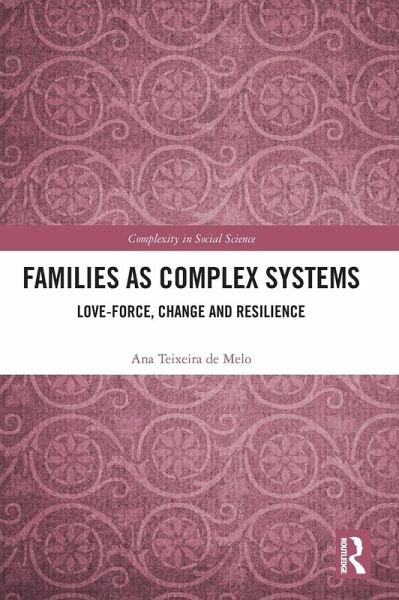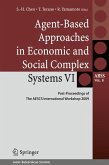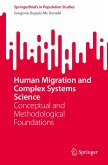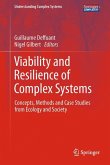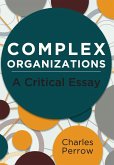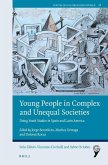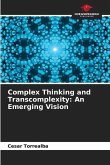- Gebundenes Buch
- Merkliste
- Auf die Merkliste
- Bewerten Bewerten
- Teilen
- Produkt teilen
- Produkterinnerung
- Produkterinnerung
This book presents an innovative framework for conceptualising families as complex systems and for understanding and supporting positive change, adaptation and resilience. The development of this framework was based on a qualitative and abductive research process targeting change and resilience processes in multi-challenged families.
Andere Kunden interessierten sich auch für
![Agent-Based Approaches in Economic and Social Complex Systems VI Agent-Based Approaches in Economic and Social Complex Systems VI]() Agent-Based Approaches in Economic and Social Complex Systems VI112,99 €
Agent-Based Approaches in Economic and Social Complex Systems VI112,99 €![Human Migration and Complex Systems Science Human Migration and Complex Systems Science]() Gregorie Dupuis-Mc DonaldHuman Migration and Complex Systems Science38,99 €
Gregorie Dupuis-Mc DonaldHuman Migration and Complex Systems Science38,99 €![Viability and Resilience of Complex Systems Viability and Resilience of Complex Systems]() Viability and Resilience of Complex Systems75,99 €
Viability and Resilience of Complex Systems75,99 €![Complex Organizations Complex Organizations]() Charles PerrowComplex Organizations33,99 €
Charles PerrowComplex Organizations33,99 €![Young People in Complex and Unequal Societies Young People in Complex and Unequal Societies]() Young People in Complex and Unequal Societies188,99 €
Young People in Complex and Unequal Societies188,99 €![Complex Human Dynamics Complex Human Dynamics]() Complex Human Dynamics75,99 €
Complex Human Dynamics75,99 €![Complex Thinking and Transcomplexity: An Emerging Vision Complex Thinking and Transcomplexity: An Emerging Vision]() Cesar TorrealbaComplex Thinking and Transcomplexity: An Emerging Vision40,99 €
Cesar TorrealbaComplex Thinking and Transcomplexity: An Emerging Vision40,99 €-
-
-
This book presents an innovative framework for conceptualising families as complex systems and for understanding and supporting positive change, adaptation and resilience. The development of this framework was based on a qualitative and abductive research process targeting change and resilience processes in multi-challenged families.
Hinweis: Dieser Artikel kann nur an eine deutsche Lieferadresse ausgeliefert werden.
Hinweis: Dieser Artikel kann nur an eine deutsche Lieferadresse ausgeliefert werden.
Produktdetails
- Produktdetails
- Verlag: Taylor & Francis Ltd
- Seitenzahl: 424
- Erscheinungstermin: 4. Juli 2025
- Englisch
- Abmessung: 254mm x 178mm
- Gewicht: 453g
- ISBN-13: 9781138699212
- ISBN-10: 1138699217
- Artikelnr.: 55794591
- Herstellerkennzeichnung
- Libri GmbH
- Europaallee 1
- 36244 Bad Hersfeld
- gpsr@libri.de
- Verlag: Taylor & Francis Ltd
- Seitenzahl: 424
- Erscheinungstermin: 4. Juli 2025
- Englisch
- Abmessung: 254mm x 178mm
- Gewicht: 453g
- ISBN-13: 9781138699212
- ISBN-10: 1138699217
- Artikelnr.: 55794591
- Herstellerkennzeichnung
- Libri GmbH
- Europaallee 1
- 36244 Bad Hersfeld
- gpsr@libri.de
Ana Teixeira de Melo is a Psychologist and Researcher at the Centre for Social Studies, University of Coimbra, Portugal. She has been tracing a highly interdisciplinary research pathway working at the crossroads of different domains and in close contact with contexts of professional practice. She has been exploring contributions of complexity-informed frameworks to understanding change processes in human systems and to guide the management of change and interventions in complex human systems. She is the author of Performing Complexity: Building Foundations for the Practice of Complex Thinking (2020) and of family programs such as the Integrated Family Assessment and Intervention Model (2011), Travelling Through Lands of Parenthood (2014) and Searching Family Treasure (2009).
PART I
1. Introduction
2. Methodological notes
PART II
3. The complexity in the definition of families
4. Perspectives on families as systems: Multidimensional complexity
PART III
5. Systems and complexity: Contributions to understanding family complexity
6. A framework for understanding Love-Force and families as a Complex
Systems (FACS): An overview
7. Coupling processes and patterns: the self-organisation of families
8. General features of the complexity of family bonds
9. Properties and potentials of the the bonds as emergent coupling patterns
10. Love-Force: Transformative bonds and the families¿ internal potential
for change
11. Individual capacity for Love-Force and contributions to the coupling
process
12. Loving interactions: The coordination of individual contributions
through reciprocal coupling
13. Loving environments across the Family Life Coupling Space: From bonds
to networks and family environments
14. Boundaries and configurations of the family network of bonds
PART IV
15. Family change processes: the complexity of positive family change and
resilience
16. Positive pathways of change, adaptation and resilience through
Love-Force: Individual, reciprocal and bond level strategies
17. Positive pathways of change, adaptation and resilience through
Love-Force: Network level strategies, external processes and contributions
from the functional and specific potential for change
18. Tailoring assessments and interventions to the complexity of a family
case and the potential for family change
PART V
19. Final reflections: Future challenges for research and practice
1. Introduction
2. Methodological notes
PART II
3. The complexity in the definition of families
4. Perspectives on families as systems: Multidimensional complexity
PART III
5. Systems and complexity: Contributions to understanding family complexity
6. A framework for understanding Love-Force and families as a Complex
Systems (FACS): An overview
7. Coupling processes and patterns: the self-organisation of families
8. General features of the complexity of family bonds
9. Properties and potentials of the the bonds as emergent coupling patterns
10. Love-Force: Transformative bonds and the families¿ internal potential
for change
11. Individual capacity for Love-Force and contributions to the coupling
process
12. Loving interactions: The coordination of individual contributions
through reciprocal coupling
13. Loving environments across the Family Life Coupling Space: From bonds
to networks and family environments
14. Boundaries and configurations of the family network of bonds
PART IV
15. Family change processes: the complexity of positive family change and
resilience
16. Positive pathways of change, adaptation and resilience through
Love-Force: Individual, reciprocal and bond level strategies
17. Positive pathways of change, adaptation and resilience through
Love-Force: Network level strategies, external processes and contributions
from the functional and specific potential for change
18. Tailoring assessments and interventions to the complexity of a family
case and the potential for family change
PART V
19. Final reflections: Future challenges for research and practice
PART I
1. Introduction
2. Methodological notes
PART II
3. The complexity in the definition of families
4. Perspectives on families as systems: Multidimensional complexity
PART III
5. Systems and complexity: Contributions to understanding family complexity
6. A framework for understanding Love-Force and families as a Complex
Systems (FACS): An overview
7. Coupling processes and patterns: the self-organisation of families
8. General features of the complexity of family bonds
9. Properties and potentials of the the bonds as emergent coupling patterns
10. Love-Force: Transformative bonds and the families¿ internal potential
for change
11. Individual capacity for Love-Force and contributions to the coupling
process
12. Loving interactions: The coordination of individual contributions
through reciprocal coupling
13. Loving environments across the Family Life Coupling Space: From bonds
to networks and family environments
14. Boundaries and configurations of the family network of bonds
PART IV
15. Family change processes: the complexity of positive family change and
resilience
16. Positive pathways of change, adaptation and resilience through
Love-Force: Individual, reciprocal and bond level strategies
17. Positive pathways of change, adaptation and resilience through
Love-Force: Network level strategies, external processes and contributions
from the functional and specific potential for change
18. Tailoring assessments and interventions to the complexity of a family
case and the potential for family change
PART V
19. Final reflections: Future challenges for research and practice
1. Introduction
2. Methodological notes
PART II
3. The complexity in the definition of families
4. Perspectives on families as systems: Multidimensional complexity
PART III
5. Systems and complexity: Contributions to understanding family complexity
6. A framework for understanding Love-Force and families as a Complex
Systems (FACS): An overview
7. Coupling processes and patterns: the self-organisation of families
8. General features of the complexity of family bonds
9. Properties and potentials of the the bonds as emergent coupling patterns
10. Love-Force: Transformative bonds and the families¿ internal potential
for change
11. Individual capacity for Love-Force and contributions to the coupling
process
12. Loving interactions: The coordination of individual contributions
through reciprocal coupling
13. Loving environments across the Family Life Coupling Space: From bonds
to networks and family environments
14. Boundaries and configurations of the family network of bonds
PART IV
15. Family change processes: the complexity of positive family change and
resilience
16. Positive pathways of change, adaptation and resilience through
Love-Force: Individual, reciprocal and bond level strategies
17. Positive pathways of change, adaptation and resilience through
Love-Force: Network level strategies, external processes and contributions
from the functional and specific potential for change
18. Tailoring assessments and interventions to the complexity of a family
case and the potential for family change
PART V
19. Final reflections: Future challenges for research and practice

